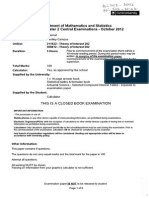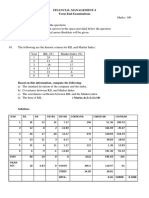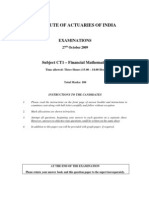Institute of Actuaries of India: Examinations
Institute of Actuaries of India: Examinations
Uploaded by
Rochak JainCopyright:
Available Formats
Institute of Actuaries of India: Examinations
Institute of Actuaries of India: Examinations
Uploaded by
Rochak JainOriginal Description:
Original Title
Copyright
Available Formats
Share this document
Did you find this document useful?
Is this content inappropriate?
Copyright:
Available Formats
Institute of Actuaries of India: Examinations
Institute of Actuaries of India: Examinations
Uploaded by
Rochak JainCopyright:
Available Formats
INSTITUTE OF ACTUARIES OF INDIA
EXAMINATIONS
27 th October 2009
Subject CT1 Financial Mathematics
Time allowed: Three Hours (15.00 18.00 Hrs)
Total Marks: 100
INSTRUCTIONS TO THE CANDIDATES
1. 2. 3. 4. Please read the instructions on the front page of answer booklet and instructions to examinees sent along with hall ticket carefully and follow without exception Mark allocations are shown in brackets. Attempt all questions, beginning your answer to each question on a separate sheet. However, answers to objective type questions could be written on the same sheet. In addition to this paper you will be provided with graph paper, if required.
AT THE END OF THE EXAMINATION Please return your answer book and this question paper to the supervisor separately.
IAI Q1)
CT1 1009 A loan of Rs.3,00,000 is to be repaid over 12 years by equated monthly installments (EMIs). The rate of interest on the loan is 8% p.a. effective. (i) Calculate the EMI. (2) (4) (2) (ii) Calculate the principal and interest content of the 57th installment. (iii) Calculate the loan outstanding immediately after payment of the 60th installment. (iv) If the loan outstanding as calculated in (iii) above is to be repaid over the next 5 years, at the same rate of interest of 8% p.a. effective, through annual installments, increasing at 5% p.a. compound, calculate the initial installment. (v) If the loan outstanding as calculated in (iii) above is to be repaid through level monthly payments of Rs.4000/- each, with a residual payment(less than Rs.4000) in the last installment, calculate the number of installments (including the installment of residual payment) in which the loan would be repaid. (vi) Calculate the residual payment made in the last installment.
(4)
(4) (2) [18]
Q2)
(i)
Prove by general reasoning that 1 = v^n +i an
(2) (4)
(ii) Prove algebraically that k n + (Ia)n-1 = (k-1)n +(I)n where k is an integer. (iii) Sanjay has choice to receive one of the following three payment streams : a) Rs. X at time 12 b) Rs.1250 at time n, Rs.2500 at time 2n, Rs.3750 at time 3n c) Rs. 6500 at time 10 The present value of all the three payment streams are equal at interest rate of i p.a. effective. Given that v^n = 0.517541, Calculate i and X. (iv) A Company issues a 10 year annuity payable annually in arrear, with the following features:? The first annuity payment is of Rs.100, and subsequent annuity payments increase by 5% p.a. compound. ? Each time the annuity is paid, the Company incurs expenses, as under: First year 4% of the annuity amount Thereafter 4% of the annuity paid in the respective year, inflating at 4% p.a. compound. Find the purchase price of the annuity at interest rate of 9.2% p.a. effective.
(4)
(6) [16]
Page 2 of 4
IAI Q3)
CT1 1009 (i) List four limitations of Redingtons immunization theory to apply in practice. (ii) State the formula for Convexity of a series of cashflows. A Company incurs a liability to pay Rs.1000 (1+e -t/100 ) at the end of year t, where t=1,2,3,..40. It values these liabilities at interest of 5% p.a. An amount equal to the total value of the liabilities is immediately invested in two bonds, each bearing interest at 5% p.a. payable annually in arrear, one redeemable at the end of 20 years and the other at the end of 45 years. Both the bonds are issued and redeemable at par. (iii) What is the present value of the liabilities? (iv) What is the discounted mean term (DMT) of the liability outgo? (v) If the DMT of the asset proceeds is the same as the DMT of the liability outgo, how much is invested in each of the bonds? (5) (7) (8) [25] (4) (1)
Q4)
(i)
A finance company accepts deposits on the following terms : a) The term of deposit is 4 years b) Interest on deposit is 16% p.a. payable quarterly in arrear c) At the end of the term, the deposit is returned along with bonus interest equal to 25% of total gross interest paid during the term of deposit as in (b) above. If a depositor is subject to tax @ 20% on all interest payments including the bonus interest, calculate the net annual effectiv e yield to the depositor.
(5)
(ii) A special bank account has the following features : a) Any money invested by the account holder earns interest at 7% p.a. effective. b) Any interest credited to the account earns 6% pa effective. c) Interest is credited to the account annually in arrear. If an account holder has a balance of Rs.10,000 now and also makes deposits of Rs.100 every year for a period of 5 years, the first deposit being at the end of one year from now, calculate the accumulation in the account at the end of 6 years. (iii) During a particular year, the force of interest d(t) was 10% pa at the start of the year, 7% pa at the end of the 9th month and 5% pa at the end of the year. The function d(t) was linear during the two periods before and after the end of the 9th month. A sum of Rs.10,000 was deposited at the start of the year. Calculate the accumulated value at the end of the year. (4) [13]
(4)
Page 3 of 4
IAI Q5) (i) (ii) Define discounted payback period. Define payback period.
CT1 1009 (1) (1)
(iii) A company is about to set a manufacturing plant to manufacture a new model of car. To incur the cost of setting and running the operation, on 1.1.2007, it borrowed Rs. 500 crores from a bank which will charge an effective rate of interest of 10% p.a. On 1.7.07, it borrowed another Rs. 1500 crores at the same rate of interest. The bank loan is not for a fixed term but may be reduced by repayments at any time. The company decides that the price of each car will be Rs. 1,00,000. On 1.1.09 the company took a booking advance of Rs. 70,000 per car for 60,000 cars. The delivery of cars will start from 01.07.2009 and 5000 cars will be delivered uniformly over a month, for 1 year. The Company will receive the balance amount of Rs. 30,000 per car on car delivery. Thereafter, i.e., from 01.07.2010 onwards, the Company expects to sell 10,000 cars each month, which shall be delivered uniformly during each month and for which there will be no booking advance and the entire amount of Rs. 1,00,000 per car will be paid to the company at the time of sale. Calculate the discounted payback period for this project. By adopting a particular investment strategy a company expects that on average the annual yield on its funds will be 8% with a standard deviation of 7%. The yields in different years may be assumed to be independently distributed. a) Find the expected value and standard deviation of the accumulated amount after 15 years of a single investment of Rs.1000 made now. Assume further that each year 1+it has a lognormal distribution where it is the annual yield on companys funds in year t. b) Calculate the parameters of the lognormal distribution. c) Calculate the probability that a single investment of Re.1/- made now will be less than 60% of its expected value. (4) (3) [10] Q7) (i) What is a forward contract? (2) (3) (8) [10]
Q6)
(ii) State the formula for calculating the forward price for a) a security with no income b) c) a security with fixed cash income a security with known dividend yield (3) (1) (2) [8] ****************** Page 4 of 4
Explain all the notations used in the formulae. (iii) Explain what is meant by term structure of interest rates. (iv) Explain briefly any two theories that explain the term structure of interest rates.
You might also like
- CFA Level 1 Calculation Workbook: 300 Calculations to Prepare for the CFA Level 1 Exam (2024 Edition)From EverandCFA Level 1 Calculation Workbook: 300 Calculations to Prepare for the CFA Level 1 Exam (2024 Edition)Rating: 4.5 out of 5 stars4.5/5 (6)
- Series 65 Exam Practice Question Workbook: 700+ Comprehensive Practice Questions (2024 Edition)From EverandSeries 65 Exam Practice Question Workbook: 700+ Comprehensive Practice Questions (2024 Edition)No ratings yet
- Day Trading Strategies You Need To KnowDocument20 pagesDay Trading Strategies You Need To Knowjeevandran0% (1)
- CFP Exam Calculation Workbook: 400+ Calculations to Prepare for the CFP Exam (2019 Edition)From EverandCFP Exam Calculation Workbook: 400+ Calculations to Prepare for the CFP Exam (2019 Edition)Rating: 5 out of 5 stars5/5 (1)
- Sample Agreement For An Interest Free Islamic LoanDocument2 pagesSample Agreement For An Interest Free Islamic LoanEthica Institute of Islamic Finance™67% (3)
- 102 QP 1003Document6 pages102 QP 1003api-3701114No ratings yet
- IandF CT1 201709 ExamDocument6 pagesIandF CT1 201709 ExamViorel AdirvaNo ratings yet
- Multiple Choice Questions - Theory Current LiabilitiesDocument41 pagesMultiple Choice Questions - Theory Current LiabilitiesJulius Lester Abiera100% (1)
- Actuarial Society of India Examinations: Subject 102 - Financial MathematicsDocument5 pagesActuarial Society of India Examinations: Subject 102 - Financial MathematicsbrcsNo ratings yet
- Actuarial Society of India: ExaminationsDocument5 pagesActuarial Society of India: ExaminationsdasNo ratings yet
- Institute of Actuaries of India: ExaminationsDocument5 pagesInstitute of Actuaries of India: ExaminationsHemanshu JainNo ratings yet
- Institute of Actuaries of India: ExaminationsDocument5 pagesInstitute of Actuaries of India: ExaminationsdasNo ratings yet
- CT1 QP 0506Document4 pagesCT1 QP 0506Subhash KumarNo ratings yet
- Institute of Actuaries of India: ExaminationsDocument6 pagesInstitute of Actuaries of India: ExaminationsmailrahulrajNo ratings yet
- FandI Subj102 200009 Exampaper PDFDocument4 pagesFandI Subj102 200009 Exampaper PDFClerry SamuelNo ratings yet
- Examinations: Subject 102 - Financial MathematicsDocument5 pagesExaminations: Subject 102 - Financial MathematicsClerry SamuelNo ratings yet
- Institute and Faculty of Actuaries: Subject CT1 - Financial Mathematics Core TechnicalDocument6 pagesInstitute and Faculty of Actuaries: Subject CT1 - Financial Mathematics Core TechnicalfeererereNo ratings yet
- CT1 QP 1114Document5 pagesCT1 QP 1114Anonymous Eibg11N9xNNo ratings yet
- Institute and Faculty of Actuaries: Subject CT1 - Financial Mathematics Core TechnicalDocument40 pagesInstitute and Faculty of Actuaries: Subject CT1 - Financial Mathematics Core TechnicalVladmirNo ratings yet
- Financial Management 532635578Document30 pagesFinancial Management 532635578viaan1990No ratings yet
- CM1A - September 2024 - Exam PaperDocument6 pagesCM1A - September 2024 - Exam PaperbadupercyNo ratings yet
- FMTS SampleExam (Q)Document3 pagesFMTS SampleExam (Q)attacker1235No ratings yet
- Institute of Actuaries of India: ExaminationsDocument6 pagesInstitute of Actuaries of India: ExaminationsRochak JainNo ratings yet
- Actuarial Society of India: ExaminationsDocument5 pagesActuarial Society of India: ExaminationsBhawnaSharmaNo ratings yet
- 102 QP 0504Document5 pages102 QP 0504api-3701114No ratings yet
- Edu 2015 Exam FM Ques TheoryDocument44 pagesEdu 2015 Exam FM Ques TheoryLueshen WellingtonNo ratings yet
- Institute and Faculty of Actuaries: Subject CT1 - Financial Mathematics Core TechnicalDocument19 pagesInstitute and Faculty of Actuaries: Subject CT1 - Financial Mathematics Core Technicalankitag612No ratings yet
- Exam FileDocument14 pagesExam FileAbelNo ratings yet
- Edu 2009 Fall Exam FM QuesDocument34 pagesEdu 2009 Fall Exam FM Quescl85ScribNo ratings yet
- Financial Management-I Term End Examinations: 31 Stdev 14.30 10.91 Beta 0.26 CORRR 0.1988Document7 pagesFinancial Management-I Term End Examinations: 31 Stdev 14.30 10.91 Beta 0.26 CORRR 0.1988EshanMishraNo ratings yet
- Actuarial CT1 Financial Mathematics Sample Paper 2011 by ActuarialAnswersDocument8 pagesActuarial CT1 Financial Mathematics Sample Paper 2011 by ActuarialAnswersActuarialAnswersNo ratings yet
- CS Final - Financial Tresurs and Forex Management - June 2004Document4 pagesCS Final - Financial Tresurs and Forex Management - June 2004Rushikesh DeshmukhNo ratings yet
- Institute and Faculty of Actuaries: Subject CT1 - Financial Mathematics Core TechnicalDocument7 pagesInstitute and Faculty of Actuaries: Subject CT1 - Financial Mathematics Core TechnicalfeererereNo ratings yet
- 2018 10 Exam FM Sample QuestionsDocument137 pages2018 10 Exam FM Sample QuestionsRuoyuNo ratings yet
- Section A: Question 1 - Compulsory (40 Marks) IDocument4 pagesSection A: Question 1 - Compulsory (40 Marks) IJay Napstar NkomoNo ratings yet
- AFIN209 2018 Semester 1 Final Exam PDFDocument6 pagesAFIN209 2018 Semester 1 Final Exam PDFGeorge MandaNo ratings yet
- Numerical Questions 5Document3 pagesNumerical Questions 5nabin bkNo ratings yet
- Interest Theory QuestionsDocument65 pagesInterest Theory Questionsshivanithapar13100% (1)
- Corporate Valuation NumericalsDocument47 pagesCorporate Valuation Numericalspasler9929No ratings yet
- CT1 Assignment Chapter 14Document5 pagesCT1 Assignment Chapter 14Gaurav satraNo ratings yet
- 2018 10 Exam FM Sample Questions 2Document137 pages2018 10 Exam FM Sample Questions 2RuoyuNo ratings yet
- Time Value of Money SumsDocument13 pagesTime Value of Money SumsrahulNo ratings yet
- FM I AssignmentDocument3 pagesFM I AssignmentApeksha S KanthNo ratings yet
- CT1 Exam PaperDocument8 pagesCT1 Exam PaperJames TriviaNo ratings yet
- 10-12 Assignment 1Document4 pages10-12 Assignment 1Pavan Kasireddy100% (1)
- Sac 300: Financial Mathematics: Question 1 (30 Marks)Document4 pagesSac 300: Financial Mathematics: Question 1 (30 Marks)Anne Atieno NdoloNo ratings yet
- Exam FM QuestioonsDocument102 pagesExam FM Questioonsnkfran100% (2)
- 2018 10 Exam FM Sample QuestionsDocument184 pages2018 10 Exam FM Sample QuestionsyrleteboroNo ratings yet
- 2018 10 Exam FM Sample QuestionsDocument110 pages2018 10 Exam FM Sample QuestionsLinh Trần GiaNo ratings yet
- Edu 2015 Exam FM Ques Theory PDFDocument65 pagesEdu 2015 Exam FM Ques Theory PDF彭雅欣No ratings yet
- Examination: Subject CT1 - Financial Mathematics Core TechnicalDocument5 pagesExamination: Subject CT1 - Financial Mathematics Core TechnicalfeererereNo ratings yet
- Ie342 SS4Document8 pagesIe342 SS4slnyzclrNo ratings yet
- Corporate Financing Decisions, Fall 2016Document4 pagesCorporate Financing Decisions, Fall 2016Ashok BistaNo ratings yet
- BSF 1102 - Principles of Finance - November 2022Document6 pagesBSF 1102 - Principles of Finance - November 2022JulianNo ratings yet
- CH 2Document4 pagesCH 2Sayandeep Nag0% (1)
- Tutorial I, II, III, IV QuestionsDocument15 pagesTutorial I, II, III, IV QuestionsAninda DuttaNo ratings yet
- CFP Certification Exam Practice Question Workbook: 1,000 Comprehensive Practice Questions (2019 Edition)From EverandCFP Certification Exam Practice Question Workbook: 1,000 Comprehensive Practice Questions (2019 Edition)Rating: 5 out of 5 stars5/5 (1)
- FPQP Practice Question Workbook: 1,000 Comprehensive Practice Questions (2024 Edition)From EverandFPQP Practice Question Workbook: 1,000 Comprehensive Practice Questions (2024 Edition)No ratings yet
- Securitization in India: Managing Capital Constraints and Creating Liquidity to Fund Infrastructure AssetsFrom EverandSecuritization in India: Managing Capital Constraints and Creating Liquidity to Fund Infrastructure AssetsNo ratings yet
- A Comparative Analysis of Tax Administration in Asia and the Pacific: Fifth EditionFrom EverandA Comparative Analysis of Tax Administration in Asia and the Pacific: Fifth EditionNo ratings yet
- Personal Money Management Made Simple with MS Excel: How to save, invest and borrow wiselyFrom EverandPersonal Money Management Made Simple with MS Excel: How to save, invest and borrow wiselyNo ratings yet
- May 2015 Time TableDocument1 pageMay 2015 Time TableRochak JainNo ratings yet
- Institute of Actuaries of India: ExaminationsDocument6 pagesInstitute of Actuaries of India: ExaminationsRochak JainNo ratings yet
- Institute of Actuaries of India: ExaminationsDocument4 pagesInstitute of Actuaries of India: ExaminationsRochak JainNo ratings yet
- Stefane@it Uu SeDocument27 pagesStefane@it Uu SeRochak JainNo ratings yet
- Fnyyh Fo'Ofo - Ky : Date-Sheet For B.Sc. (Honours) Part-I, Ii & Iii (I/Iii/V Semester)Document3 pagesFnyyh Fo'Ofo - Ky : Date-Sheet For B.Sc. (Honours) Part-I, Ii & Iii (I/Iii/V Semester)Rochak JainNo ratings yet
- Subject CT3 Probability and Mathematical Statistics Core Technical SyllabusDocument7 pagesSubject CT3 Probability and Mathematical Statistics Core Technical SyllabusRochak JainNo ratings yet
- Arithmetic - Simple InterestDocument2 pagesArithmetic - Simple InterestKrishnaNo ratings yet
- Research ProposalDocument49 pagesResearch ProposalAmanuel HawiNo ratings yet
- Quiz 1Document29 pagesQuiz 1Camille BagadiongNo ratings yet
- BANK3011 Workshop Week 6 SolutionsDocument5 pagesBANK3011 Workshop Week 6 SolutionsZahraaNo ratings yet
- Pefindo'S Corporate Default and Rating Transition Study (1996 - 2010)Document21 pagesPefindo'S Corporate Default and Rating Transition Study (1996 - 2010)Theo VladimirNo ratings yet
- New PM CasesDocument15 pagesNew PM CasesChirag Nahar33% (3)
- Minicase - Term Structure Interest RateDocument2 pagesMinicase - Term Structure Interest RateTho ThoNo ratings yet
- PeSukuk - PHS - 3 IN 1Document17 pagesPeSukuk - PHS - 3 IN 1hairyna37No ratings yet
- Company Analysis of IHCL by M. Shanthan - 19FMUCHH010231Document25 pagesCompany Analysis of IHCL by M. Shanthan - 19FMUCHH010231Shanthan ReddyNo ratings yet
- Altaf Ahmad 314472 BESE10B Quiz3Document6 pagesAltaf Ahmad 314472 BESE10B Quiz3Altaf AhmadNo ratings yet
- End of Chap 6 AnswersDocument28 pagesEnd of Chap 6 AnswersAdamNo ratings yet
- Investor Survey 4q21Document42 pagesInvestor Survey 4q21kcteodoroNo ratings yet
- Agreement N Nyakaembe Report 2023-2024Document39 pagesAgreement N Nyakaembe Report 2023-2024madadehermishNo ratings yet
- Concept of Commercial Banks of Nepa1Document8 pagesConcept of Commercial Banks of Nepa1vanvunNo ratings yet
- Strategic Management: Final Exam 1-25. True or False 26-50. IdentificationDocument4 pagesStrategic Management: Final Exam 1-25. True or False 26-50. IdentificationMarie GarpiaNo ratings yet
- Roosevelt Cayman V Benitez-RodriguezDocument17 pagesRoosevelt Cayman V Benitez-RodriguezMolly GottNo ratings yet
- Microfinance 140113043356 Phpapp01Document40 pagesMicrofinance 140113043356 Phpapp01karanjangid17No ratings yet
- Plaintiff-Appellee Vs Vs Defendant-Appellant: en BancDocument3 pagesPlaintiff-Appellee Vs Vs Defendant-Appellant: en BancCams Tres ReyesNo ratings yet
- CH 14Document13 pagesCH 14Ranjan PradhanNo ratings yet
- ACC106 P2 Quiz 1 Questions Set A KDocument3 pagesACC106 P2 Quiz 1 Questions Set A KLeddie Bergs Villanueva VelascoNo ratings yet
- BF R. Kit As at 25 April 2006Document255 pagesBF R. Kit As at 25 April 2006Winny Shiru Machira100% (2)
- Dinla CoDocument12 pagesDinla CoShamsuzzaman SunNo ratings yet
- 19 Upazila Attachment ReportDocument29 pages19 Upazila Attachment ReportSouvenir 120th LACNo ratings yet
- Chapter 3 Time Value of Money PDFDocument16 pagesChapter 3 Time Value of Money PDFmuluken walelgn100% (1)
- Commercialstudies PDFDocument210 pagesCommercialstudies PDFDove PaeaNo ratings yet
- Lesson 05 - Fiscal Policy and StabilizationDocument48 pagesLesson 05 - Fiscal Policy and StabilizationMetoo ChyNo ratings yet
- 2008 Certificates of Participation Official Statement PDFDocument225 pages2008 Certificates of Participation Official Statement PDFRoldan Hiano ManganipNo ratings yet






























































































